Today is the eighth day after Saint Francis’s feast on October 4. Only the Franciscans still celebrate the Octave, but I thought it would be a fitting day to publish part two of my series on Giotto’s Saint Francis fresco series in the Assisi Basilica. I cover the second half of the cycle in this article, which can be read on its own, or after part one.
You have probably heard this famous quote attributed to Saint Francis, “Preach the Gospel at all times and if necessary use words.” The quote is apocryphal and does not appear in any of the numerous biographies written about Francis in the 200 years after he died. Still, people like to mention the quote and say that it represents the “spirit of Francis.” However Giotto’s frescoes, which were completed less than one hundred years after the saints death and are based on the Major Legend by Saint Bonaventure, firmly refute this assertion1.2
In Giotto’s Assisi frescoes, which were completed around the year 1300, Francis preaches in the papal palace, in a rich man’s house, at a university and even outside to birds. Giotto reminds us that preaching—with words—was one of Francis’s charisms! Francis was so dedicated to proclaiming the Gospel, the revealed Word of God, that he would preach the Gospel even when custom dictated that he probably shouldn’t do so.
By juxtaposing scenes of prayer and preaching, Giotto shows us that prayer is key to Saint Francis’s preaching. As Pope Paul VI explained, “zeal for evangelization springs from holiness which springs from a heart filled with God. Nourished by prayer and, above all, by love for the Eucharist, evangelization in turn increases holiness in the people who carry it out."
Saint Francis himself said "The preacher must first draw from secret prayers what he will later pour out in holy sermons. He must first grow hot within before he speaks words that are in themselves cold."3
The integrity of Francis’s life shone through his preaching such that a listener could tell that his words came not merely from a “head knowledge” of the Gospel but from a deep union with Christ that permeated his whole life.
The back wall of the upper church contains the most well-known of Giotto’s paintings: Francis preaching to the birds. This scene alone is a gem, but it is even more powerful when considered in situ. The arch of the two paintings, which surround the doors on the back wall, echoes the rising and falling motion from the first bay on the north wall.
When seen together with the doors, it appears Francis is praying before the portrait of the Madonna and Child, reminding us of Francis’s devotion to the child Jesus. The falling arch guides us down to the scene of Francis preaching and points to the necessary relationship between prayer and preaching.

In the first scene, Francis reaches fervently to God with his hands closed in prayer. He prays for a miracle so that the thirsty man holding his mule can have water to drink. As Moses brings forth water in the desert, Francis brings forth water for his servant at this rocky hillside.
In Giotto’s landscapes, the natural world takes on its own character and seems to sympathize with or mirror the inner state of the central figure. The vibrant landscape of jagged rocks and Francis’s outstretched arms give us a sense of the inner zeal with which Francis prays for this seemingly small thing. The man’s thirst recalls our own thirst for God, which is nourished in the church building by the liturgy and Eucharist. It reminds me of Psalm 42, "As the deer pants for the water brooks, so my soul pants for You, O God. My soul thirsts for God, for the living God."
“Let anyone who is thirsty come to me, and let the one who believes in me drink.” (John 7:37)
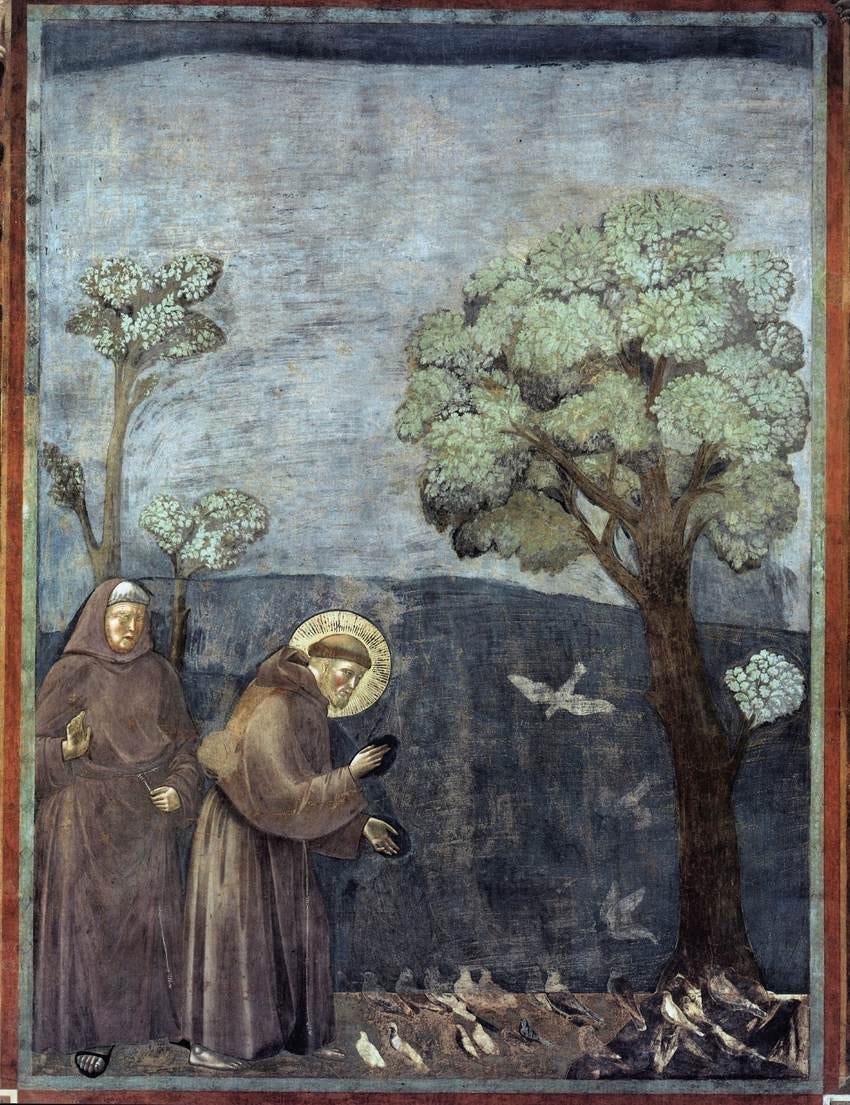
On the other side of the door, Francis blesses a group of attentive birds after instructing them to praise the Creator. The fresco is often described as tender, but it’s also quite serious and shows how important Francis understood right worship to be.4
Giotto painted these two frescos on the back wall so congregants would see the them on the way out after receiving the final blessing of the Mass, “ita missa est” (go out, you are sent). Together with the blessing, this fresco is a powerful reminder of the great commission, “Go into all the world and preach the Gospel to all creation” (Mark 16:15).
The fitting placement of these two nature scenes also reminds us that all of creation is meant to glorify God in the Cosmic liturgy. Because of Francis’s holiness, nature bends to him in an almost Edenic way, reminding us that “creation waits with eager longing.”
Giotto dedicates bay 5 on the south wall to Francis’s preaching and the miracle of the stigmata. The first three scenes take place inside Gothic buildings, while the last occurs outside beside Mount Verna. This contrast between the ornate interiors in the first three scenes and the barren mountain of the last helps to set the scene of the stigmata apart. It is the climax of the entire fresco series and of the saint’s life.
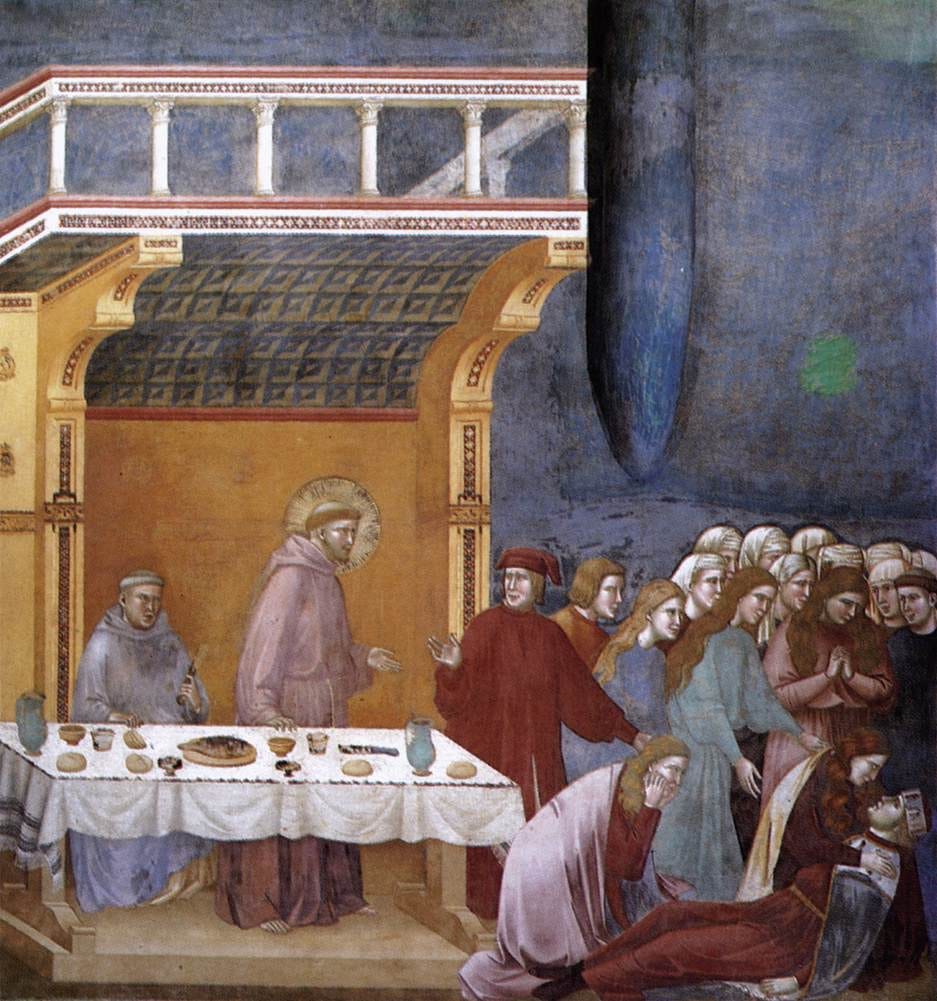
The first scene depicts a crowd of mourners standing over the body of a dead knight while Saint Francis calmly stands inside the man’s ornate house beside a table. In Bonaventure’s account, Saint Francis went to dine with a knight and upon entering his house became aware that the knight would die suddenly. Of course, Francis promptly warned the man of his impending death so that he could confess his sins and prepare spiritually to die. The knight followed Francis’s instruction, and died suddenly at dinner.
The scene is a kind of memento mori, a reminder to remember death and put our own spiritual house in order. The fact that Giotto separated the man’s dead body from his richly decorated house reminds us that we do not take any of our possessions with us after death.
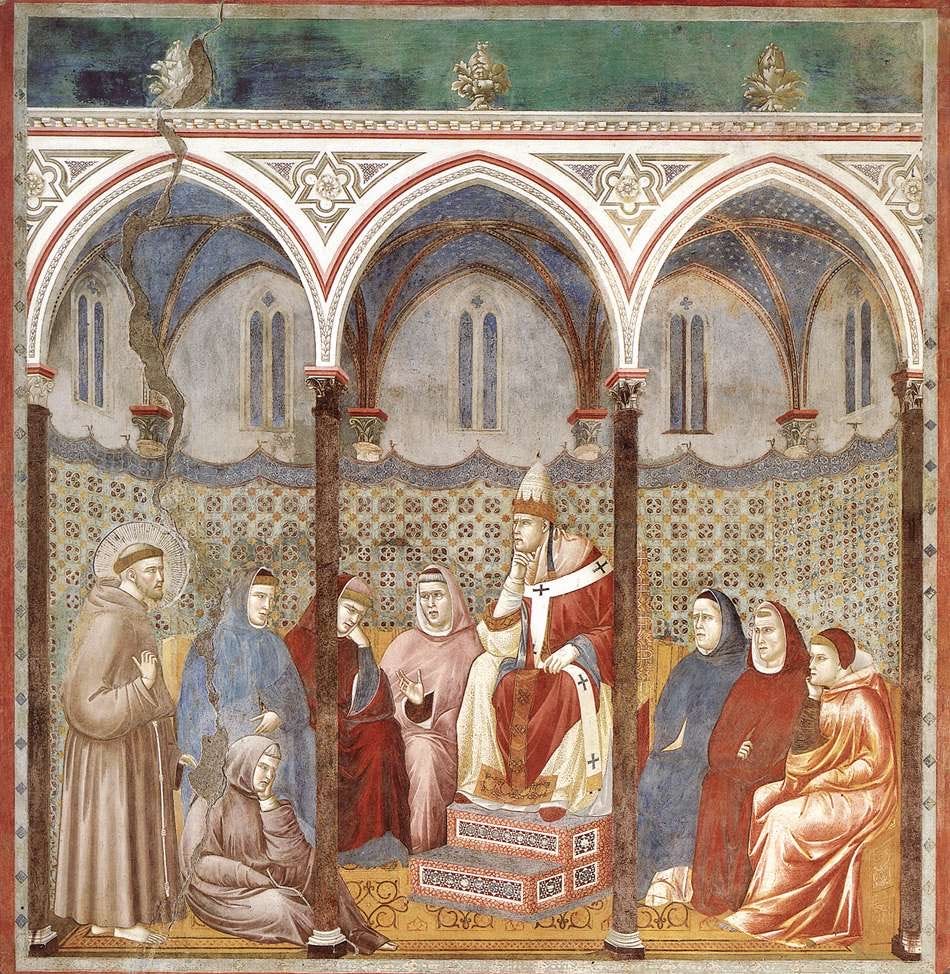
In the next scene, Francis appears in the Lateran palace again. Inspired by the Holy Spirit, the holy friar goes off script during a meeting with Pope Honorius III and gives a long sermon instead of the short one he had prepared. The fresco contrasts with Francis's first visit to the palace, where the friars knelt before the pope. Here, Francis confidently shares the Gospel with the leader of the Church on earth.
The event is also reminiscent of Christ speaking before the elders in the temple. Although the pope “outranks” Francis in the hierarchy, Francis stands above him in holiness. In his wisdom, the pope recognizes this, and is humbled by Francis’s preaching and example.
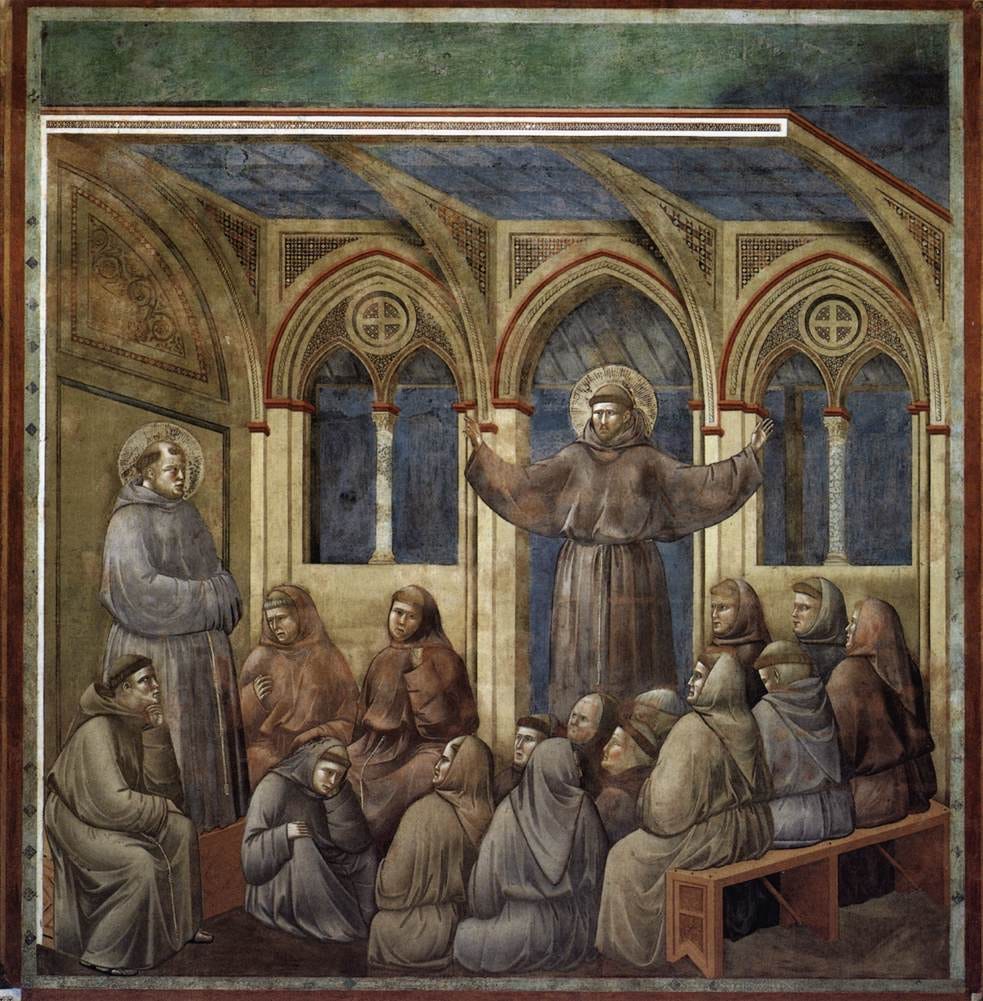
The next scene of Francis is also a preaching scene. In this particular miracle, Francis appeared miraculously to a group of friars at Arles in the middle of a lecture Anthony was giving on the inscription of the Cross. Francis stands in a cruciform posture here, reminding us of what he is speaking about and of his devotion to the crucified Christ, which culminates in the next scene.
The arches of the room at Arles mirror the arches from the Lateran palace, tying these two preaching scenes together. While the Lateran palace is richly decorated, the room at Arles is much more austere. There was no place too humble or ornate for Francis to preach. The audience here comprises a large group of friars, showing how the order has expanded since the early days. The brothers’ habits differ slightly in color, perhaps reflecting the different opinions developing among Franciscans.
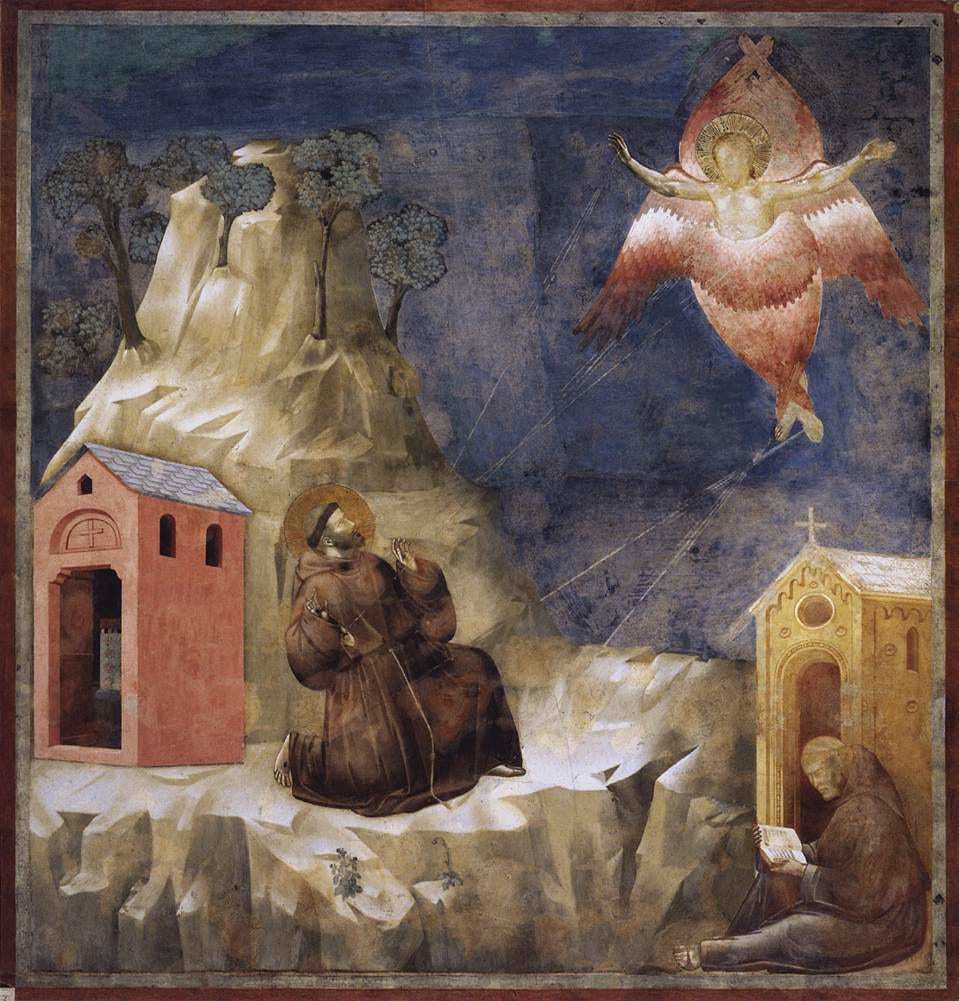
In the last scene on this bay Francis receives the stigmata. Below is Thomas of Caelano’s account,
“While he was staying in the hermitage called La Verna, two years prior to the time that he returned his soul to heaven, he saw in a divine vision a man, having six wings like a Seraph, standing over him, arms extended and feet joined, affixed on a cross. Two of his wings were raised up, two were stretched out over his head as if for flight, and two covered his whole body. When the blessed servant of the Most High saw these things, he was filled with the greatest awe, but could not decide what this vision meant for him.”
Fr Thomas Weinandy O.F.M. explains the scriptural significance of this vision:
Francis’ vision testifies that what he saw was of divine origin and not some human, psychological illusion. Moreover, Celano’s account alludes to three Scripture passages…What Francis saw was the risen crucified Jesus lifted up, the fiery serpent (Numbers 21:8) who heals from sin all who believe in him. (John 3:13-17) Moreover, and above all, Francis beheld the crucified Jesus portrayed as a glorious seraph with six wings extended. Francis was in the presence of the all-holy God. The earthly Francis was assumed into the heavenly temple wherein all cry out, “Holy, Holy, Holy is the Lord God of hosts.” (From Isaiah’s vision of the seraphs in the temple Isaiah 6:13)
Ultimately, the stigmata is a visible sign of the invisible fervor and spiritual unity Francis experienced in his relationship with the Living God. Francis conformed his life to Christ and was so moved by the power of the Cross that he was as Bonaventure says “transformed totally by a fiery, divine power into the likeness he saw.”
Giotto adds a witness to this scene, as he often does in scenes of miracles. In doing so he adds a kind of credibility to the miracle, reminding us that Francis’s stigmata was not just hearsay, but something many people saw, touched and felt. Giotto continues to remind us of this in the following scenes.
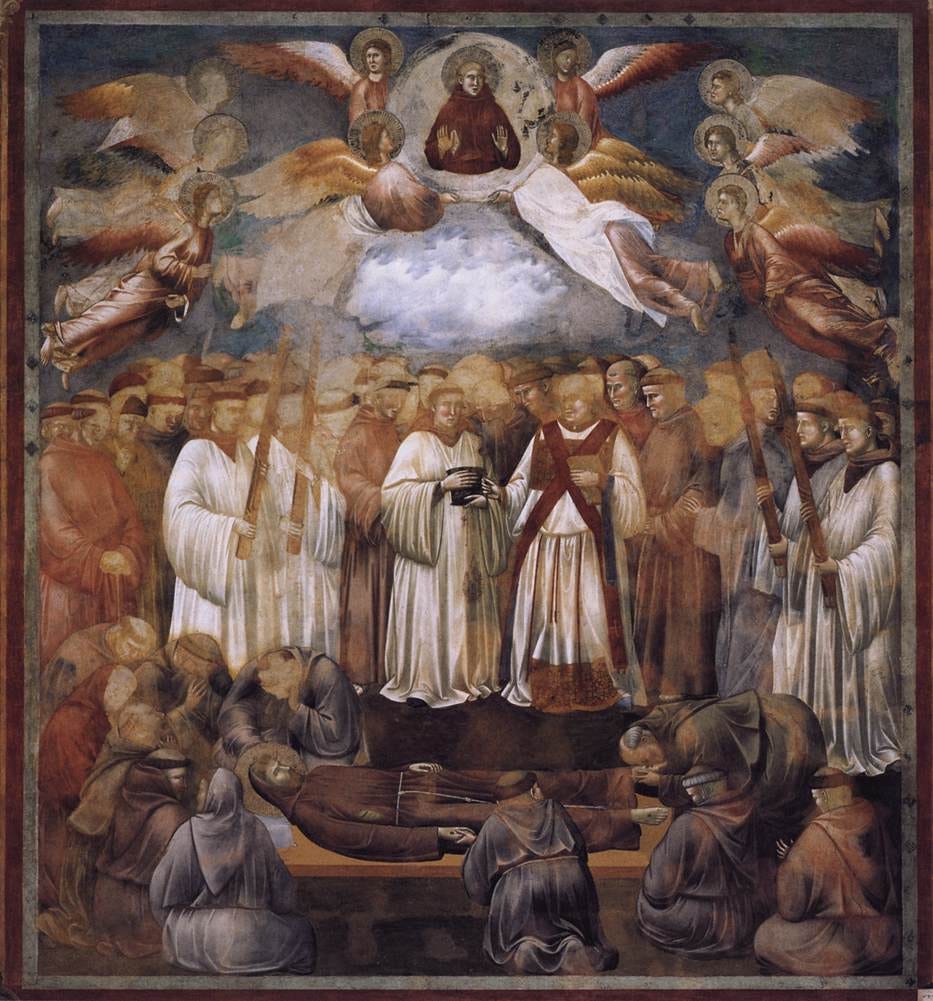
The last six scenes show Francis’s funeral rites and the miracles that followed his death. In the scene above, Giotto paints Francis lying on the ground, as he requested to be buried simply and without a coffin. One brother looks up to see him among the angels.
In the next scene featured below, Brother Agostono and the Bishop of Assisi both receive visions confirming Francis has died. By combining these scenes, Giotto reveals how Francis is important not just to his order but to the whole Church, as was forseen.
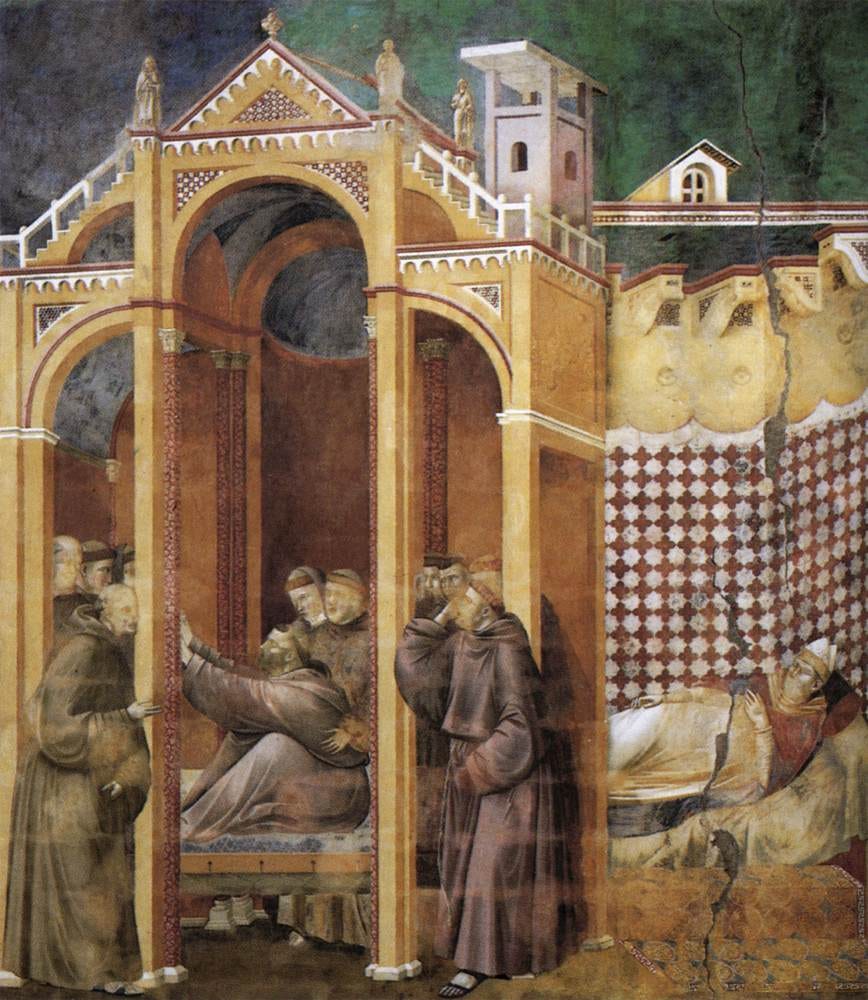
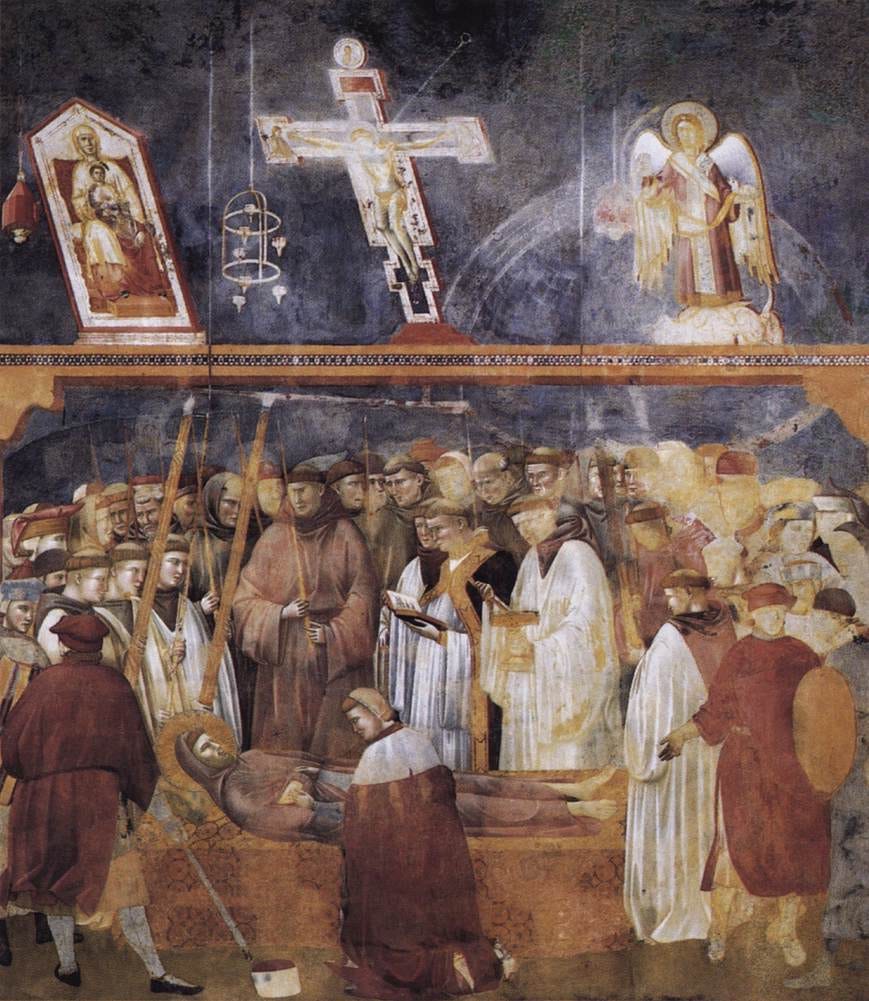
The last scene on this bay, featured above, shows Francis lying on a bed for his funeral mass surrounded by friars and clergy in the church of the Porziuncola. Saint Francis and Christ on the cross seem to bend towards each other, highlighting the union between the saint and his Lord. Girolamo, who doubted that Francis carried the wounds of the stigmata until he saw them with his own eyes, kneels before Francis and touches his wounds. Saint Michael and the Blessed Virgin Mary top the iconostasis and stand witness to the saint’s heavenly victory.
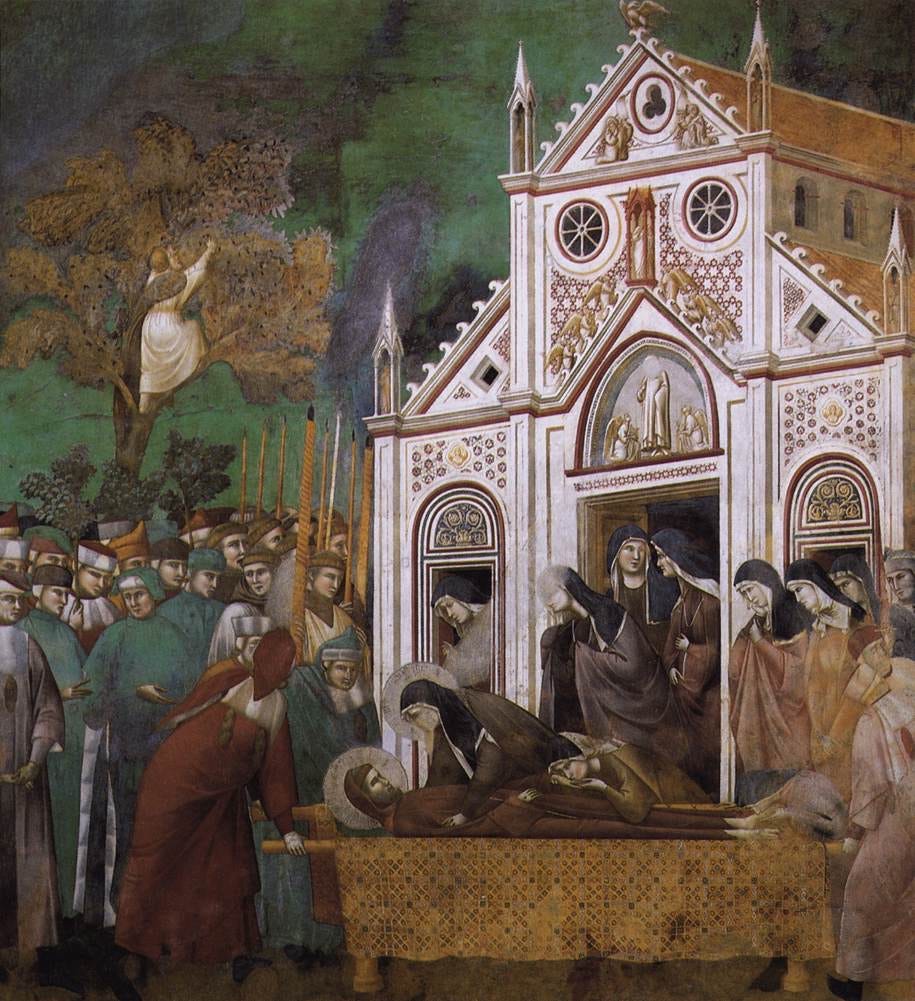
The seventh bay more than any other contains scenes that parallel with the bay directly across from it. Each scene sees more and more people come to pay respects to the little friar from Assisi. In the first scene, featured above, we revisit San Damiano church, formerly crumbling in the scene directly across from it, but now restored and glorious due to Saint Francis’s commitment to its restoration. Claire bends towards Francis and the sisters around her weep, revealing the close relationship between the Claires and the Franciscans. Claire’s tender embrace of Francis even recalls scenes of the Pieta.
The next scene, featured below, sees an even larger crowd present for Francis’s canonization with Pope Gregory IX. In the scene across from it on the north wall Francis renounces worldly goods and is rejected by his father and the crowd, but here Francis is embraced by the whole Church in a glorious ceremony.
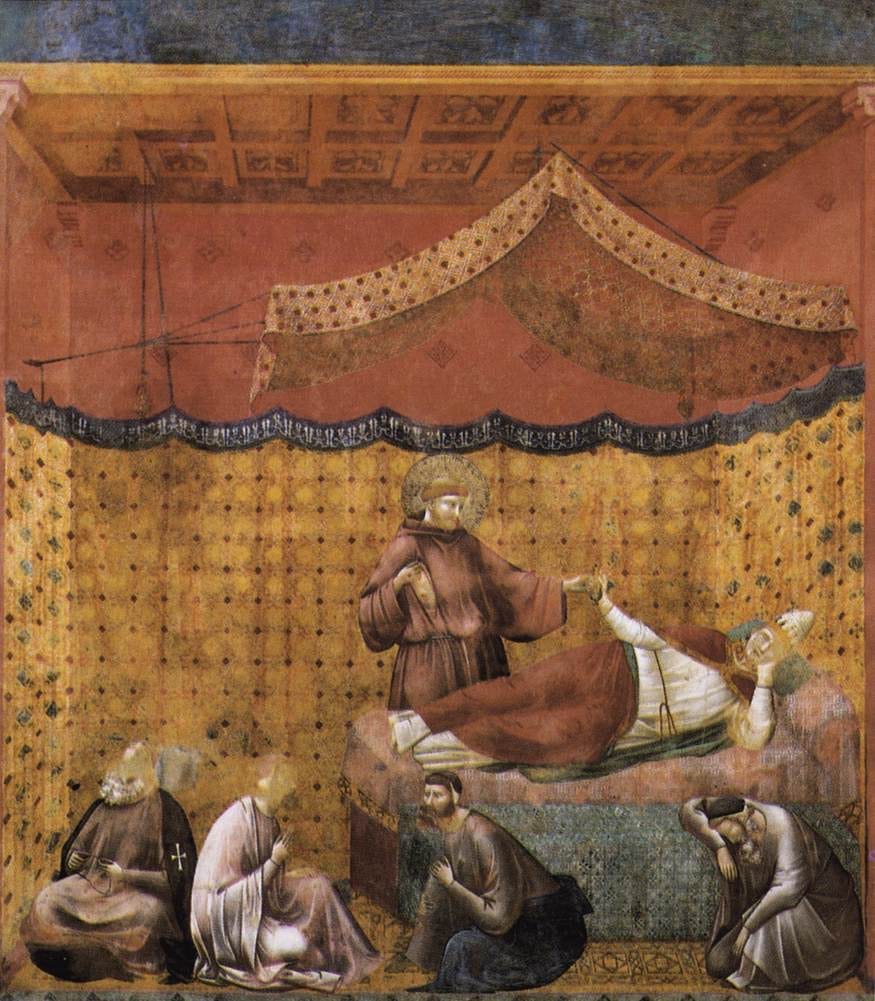
The last scene on this bay parallels Pope Innocent III’s vision of Francis holding up the church. In this scene on the south bay, Francis has entered Gregory’s bedchamber. He hands the pope a vial of his blood to rest the pope’s doubts about the wound in Francis’s side. Yet again, Giotto highlights the importance of the stigmata, which
argues is the “one of the greatest miracles of the Middle Ages.”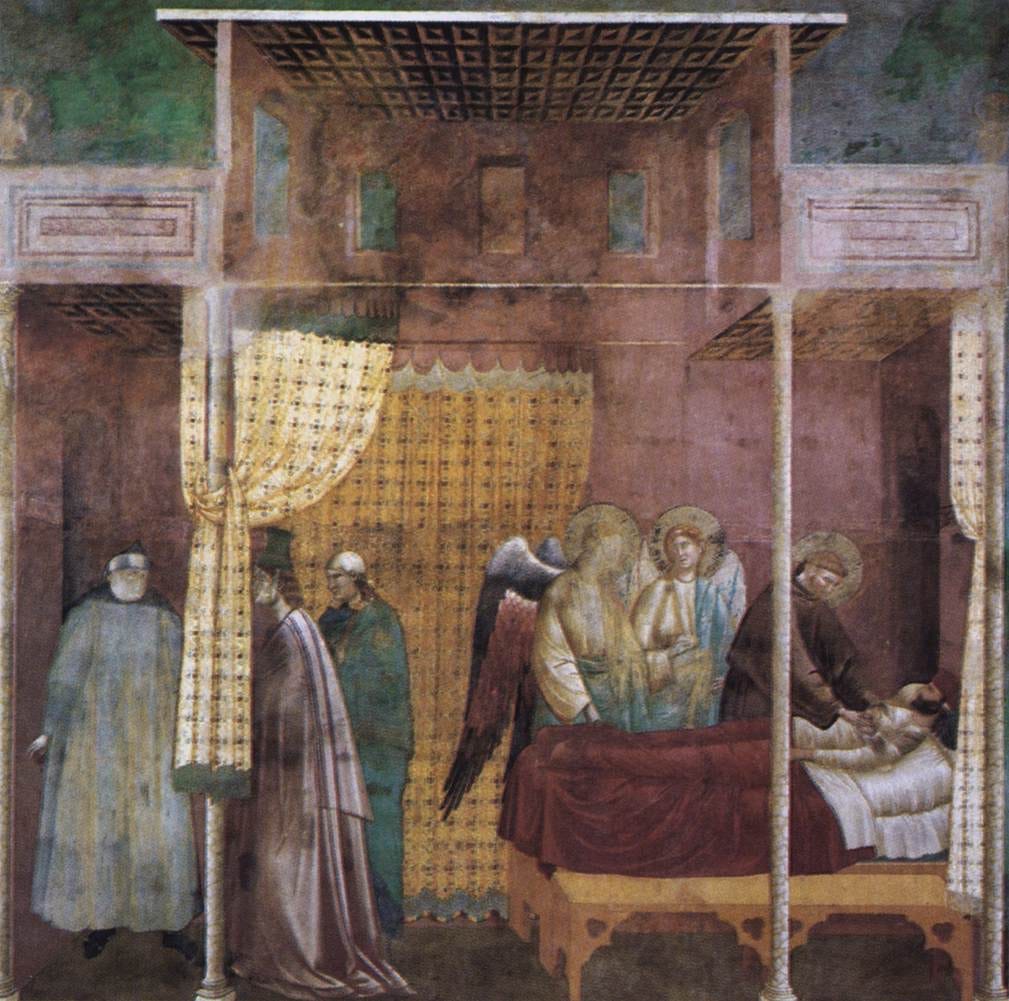
The last bay shows the way in which Francis continues to act on behalf of the layfolk of Assisi and Italy. Alive in Heaven, Francis still cares for the people of his town and remains present to them and to the Church he gave his life to restoring. In the first scene, Francis, together with a group of angels, calls upon the Lord to heal a wounded knight, pronounced incurable by a doctor. Francis touches his wounds offering heavenly comfort after the doctor, the man’s wife, and a servant dejectedly left the room.
In the middle scene, featured below, Francis kneels before Jesus, asking him to revive a woman who died withholding a serious sin. Giotto here emphasizes that is the power of Christ who makes these miracles possible. In the scene, the woman has been revived and confesses her sin to a priest while an Angel scares away the demon who came to take her. In Bonaventure’s account the woman died immediately after confessing her sin.
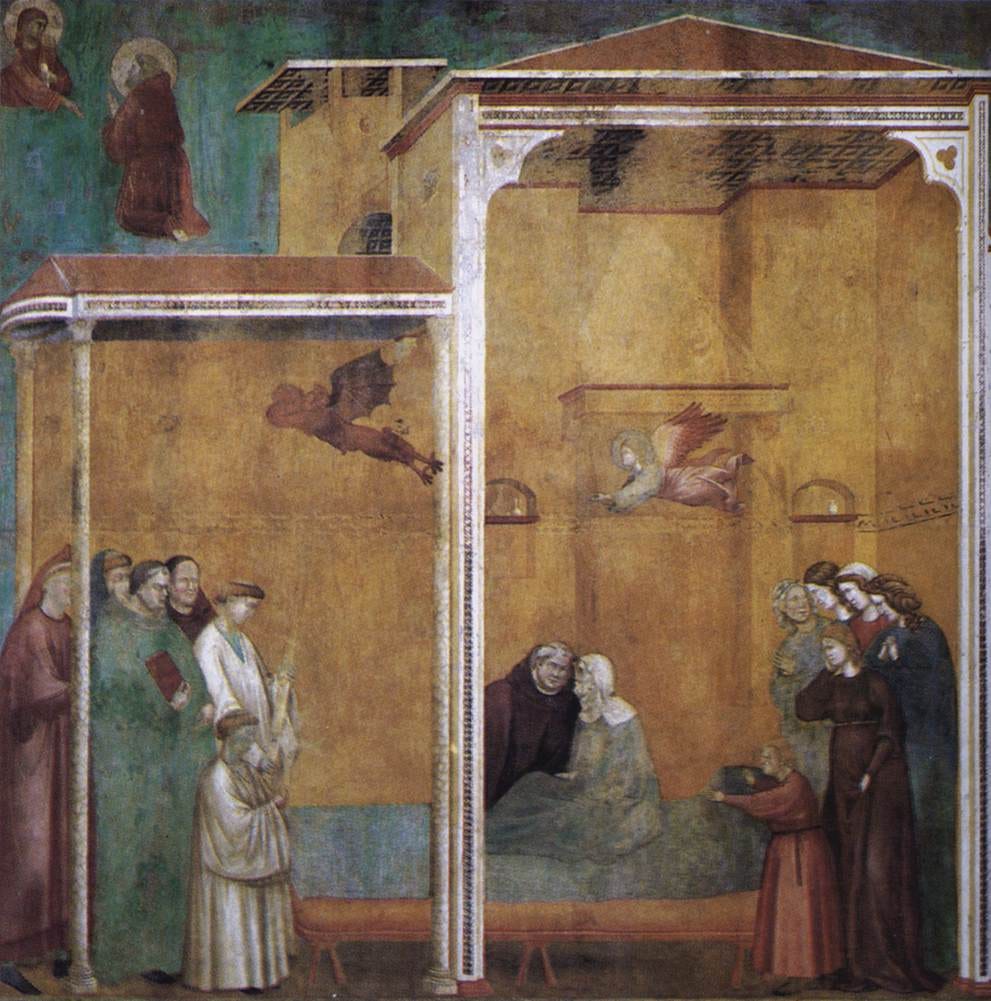
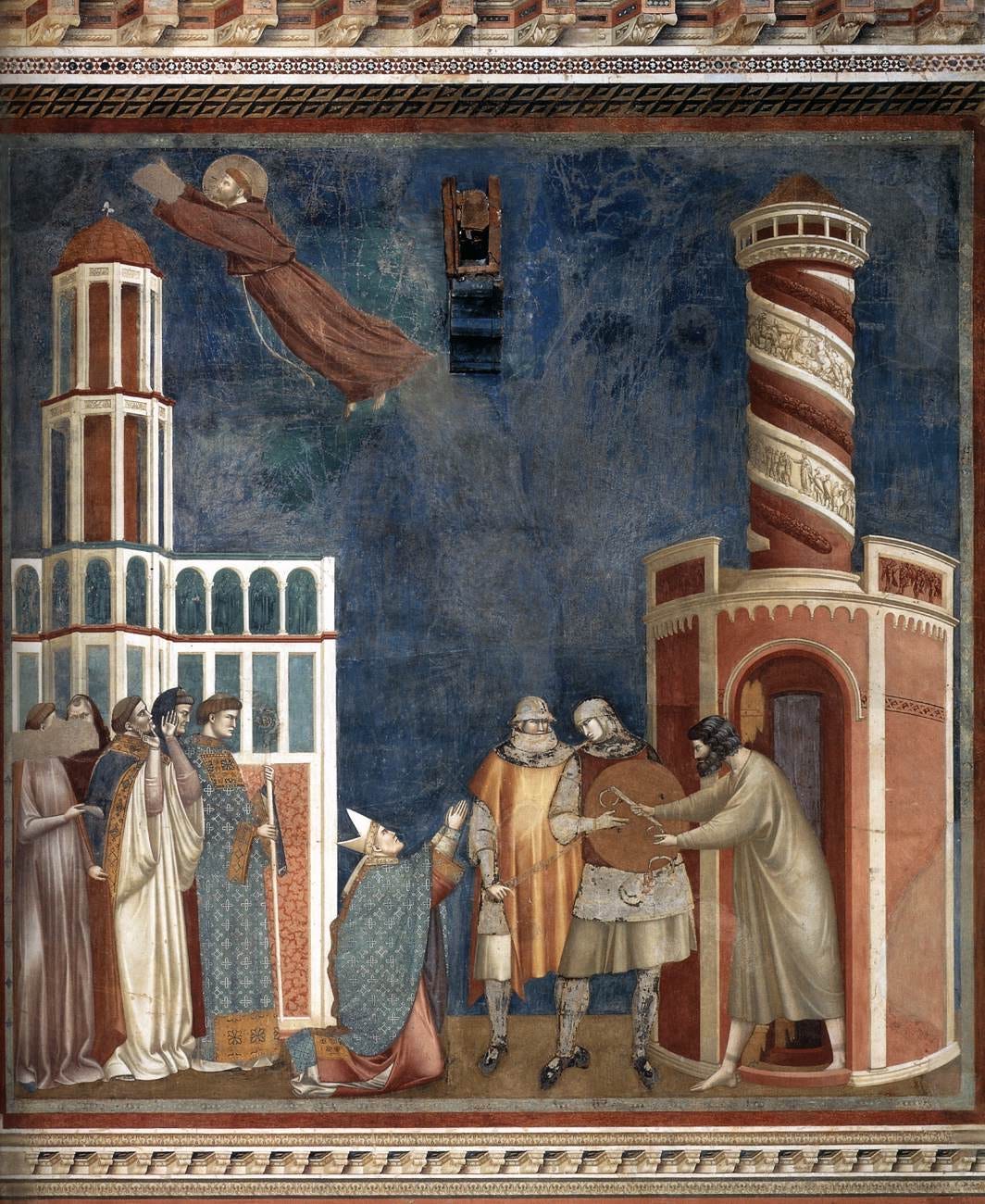
It seems fitting that Giotto begins his series with an ancient temple in Assisi and ends it next to Trajan’s ancient column in Rome. In the last scene, Francis has visited a heretic in prison, convinced the heretic to renounce his heresy, and subsequently freed the repentant heretic from his chains. In Giotto’s fresco the Bishop recognizes the miracle and kneels to worship the Lord.
While Trajan proudly erected the column to honor his own military victory, Francis humbly hid his own earthly victories, namely the stigmata, preferring to give glory to God instead of himself. After Trajan’s death, Hadrian assumed the emperor’s mantle and began erecting monuments in his own name; the greatness of his predecessor was but an afterthought. After Saint Francis’s death, Giotto and the best painters of the time marked the heavenly and earthly victories of the saint. As the column featured stories of Trajan’s many military victories, the walls of the Basilica in Assisi feature stories from Francis’s heroic life on earth and in heaven. But unlike Trajan’s stoic military heroism, Francis’s Christian heroism is one of joyful renunciation and Christ-like humility. The walls of Assisi continue to inspire and foster worship of the Living God some 800 years after the death of Francis.
Saint Francis died in the year 1226 AD.
Legend here does not mean legend as in a work of fantasy. It comes from the Latin “legenda” meaning something important to be read.
Life of Saint Francis, Thomas of Caelano
For more on this see
’s article on Saint Francis’s Eucharistic devotion: https://www.newliturgicalmovement.org/2018/09/st-francis-of-assisi-eucharistic-mystic.html?m=1



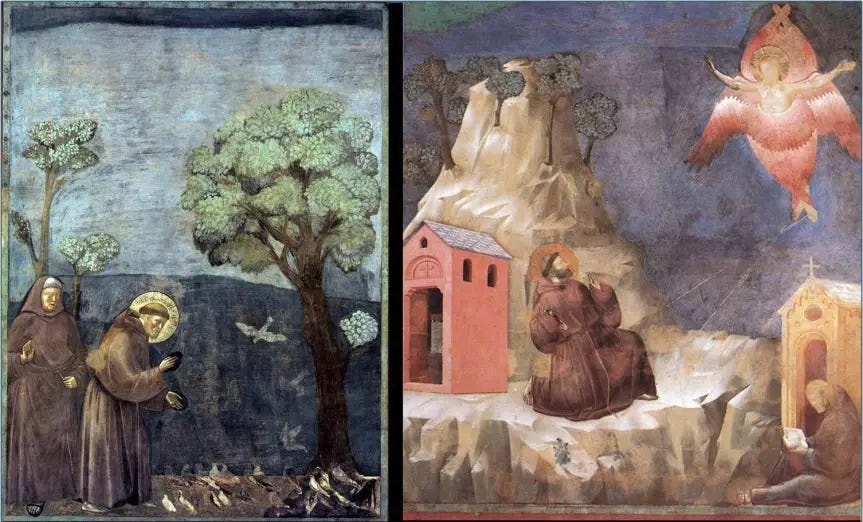

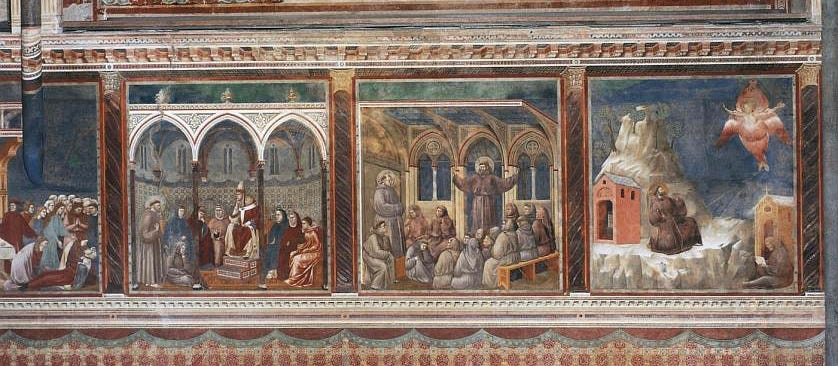
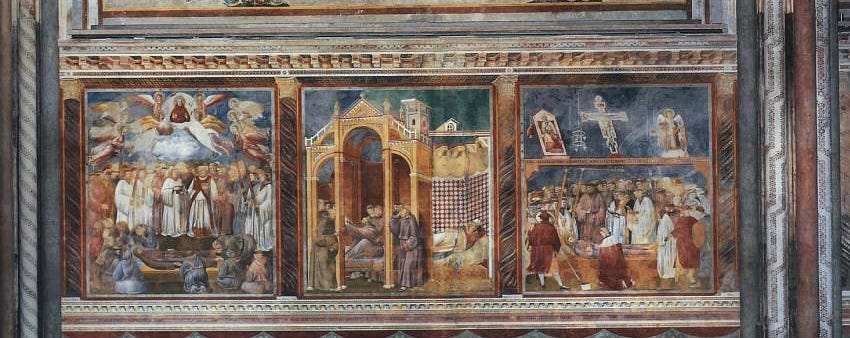
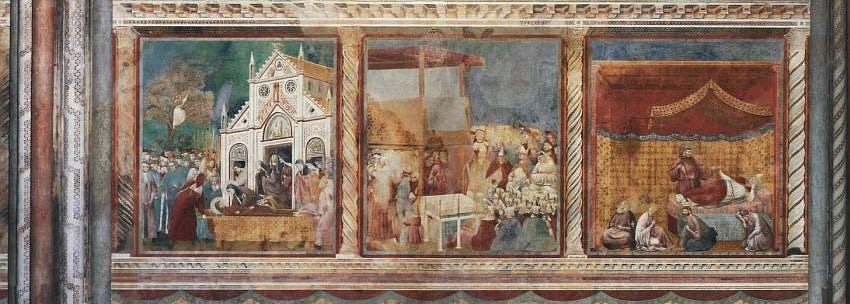
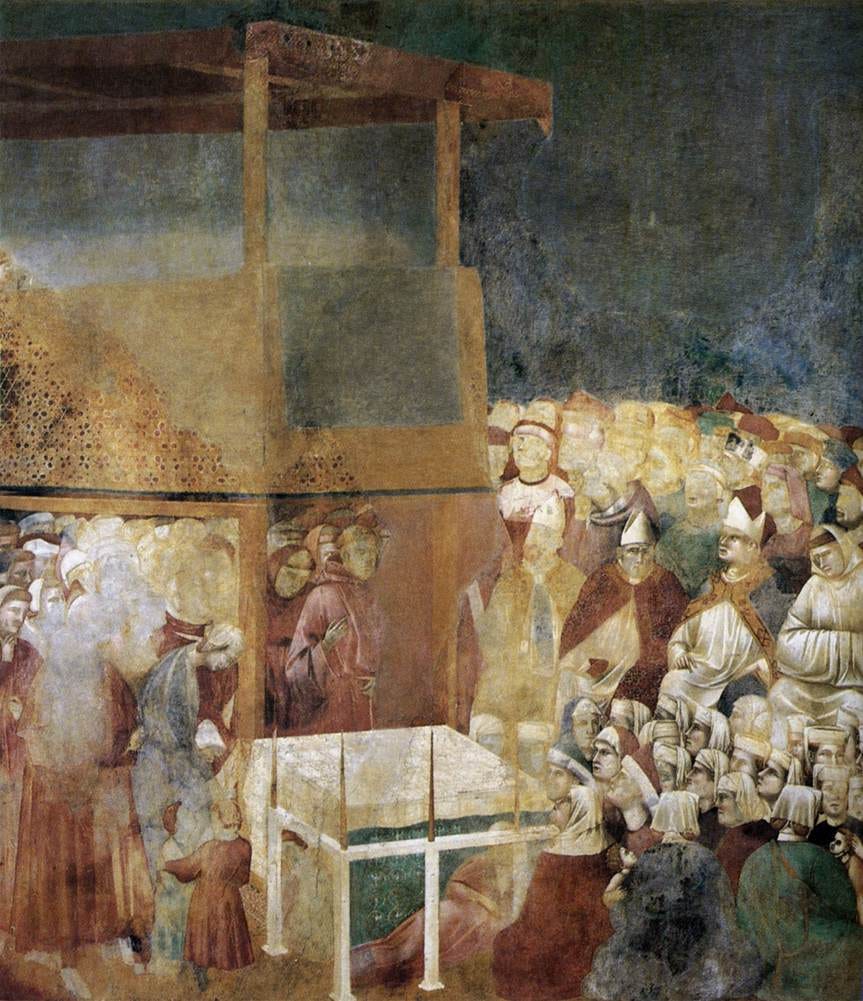
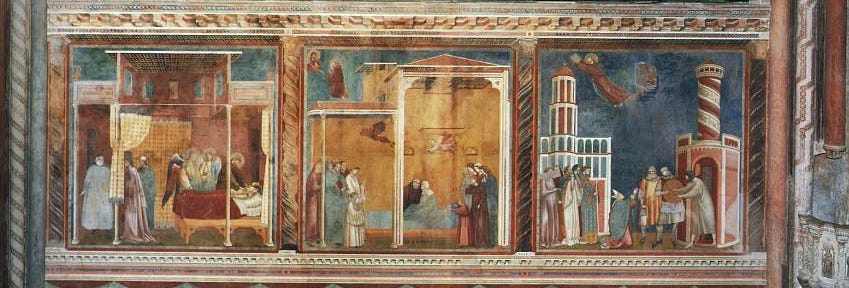
Thank you for your careful research! God bless
🇮🇹⛰️🏰🌳🐦 Umbria 😌♥️✔️🌍
<Other than the Earth Quakes> 🫨😲😬😫
Saints Francis and Clare, pray for us! ✝️⚜️